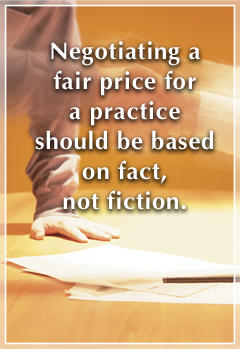|
||||||||||||||||||||||||
 |
|
|||||||||||||||||||||||
|
The Problems with Rule of Thumb: The good old “rule of thumb.” Whether you are buying or selling a practice you are sure to hear about the rule of thumb. It has been around for a long time. Many practices have been bought and sold using this method. Many are still being bought and sold using this method. Everyone has a notion as to what the rule of thumb is – or at least what they think it should be. But is hearsay the best way to determine what a practice is really worth. The rule of thumb has always been an arbitrary number, often called a multiplier, which is applied to an income-statement line-item dollar amount, in an attempt to determine what a practice should be worth. Most often, the multiplier is applied to the yearly collection total to determine value, but it also can be used on other line items such as gross sales or net income. Using the rule of thumb to value a practice has three inherent problems: |
||||||||||||||||||||||||
| |
Problem 1: Changing values. The first problem arises when you try to determine what the rule of thumb multiple should be. This number has a tendency to change values periodically and it often does so without any sound reasoning. The historical rule of thumb existed only in conversation, usually passed on from someone wanting to sell a practice to someone wanting to buy a practice.
For example: Twenty-four years ago, the chiropractor I was associating with wanted to sell his practice. His price was two times the gross sales – a fair amount, he said, because he had been told that was what other practices were selling for. Luckily, the rule of thumb didn't apply to me. I didn't have any money, so it didn't make any difference how the practice was valued! The rule of thumb multiplier has changed and is now beginning to appear in some valuation books. The authors usually state the multiplier as a general range. Today the multiplier is usually placed between 30 percent and 70 percent, without any explanation about when or how much should be applied and in which situation. The problem is obvious: If you use the published rule of thumb as a guide, a practice with a year-end collection total of $300,000 could be valued anywhere between $90,000 and $210,000. A spread of +/- $120,000 on a business collecting $300,000 is significant. The seller will want the high end (naturally), and the buyer will want to use the low-end valuation. Even if a deal can be struck somewhere between these two amounts, the question still remains: Is the compromise an accurate reflection of the value of the practice? |
 |
||||||||||||||||||||||
| Problem 2: Differences among practices. The second problem is the rule of thumb multiplier does not take into consideration the unique differences between practices, such as growth rates and the position of the practice in the business cycle.
All practices go through a cycle of rapid growth, slow growth, plateau, and decline. A new cycle may or may not begin after the decline phase. The simple rule of thumb multiplier will not be affected by the cycle, and the resulting figure will not be an accurate reflection of the true value of the practice. For example: A practice that collected $200K in 2003, $250K in 2004 and $300K in 2005 is more valuable than a practice that collected $350K in 2003, $325K in 2004 and $300K in 2005. A rule of thumb multiplier applied to each of the 2005 totals yields a similar figure, but you will have no idea if the practice is growing or declining. The position of the practice in the business cycle is information that is certainly important to the buyer, not only from a financial point of view, but also from a business planning point of view. |
||||||||||||||||||||||||
| Problem 3: Operational management. The third problem is that the rule of thumb multiplier does not take into consideration the operational management of the practice.
For example: Two generally similar practices perform the same types of services and generate similar collection totals. Each is located in a good location and has staff who are willing to stay through the transition and remain with the new doctor. But, the practices operate considerably differently. Practice A runs on referrals, spends very little on advertising, and the doctor works a 32 hour week. The doctor in Practice B works about the same number of hours, but his new patient flow has been built around promotional activities. During the valuation interview, the doctor enthusiastically discloses he has built the practice by doing only one weekend mall spinal screening per month. According to the rule of thumb, because both practices collect about the same amount they would be valued approximately the same. The difference is that the doctor in Practice B has to work an additional 24 days a year - one additional month - to generate the same amount of collections as the doctor in Practice A, who works a 32-hour week. The buyer of Practice A certainly would have the opportunity to increase hours and add promotional activities; however, the buyer of Practice B would either have to keep the same schedule or make major operational changes to maintain the expected level of income. If Practice B were bought based only on the rule of thumb, the buyer would soon have his/her enthusiasm transformed into an unwelcome surprise and a large amount of unexpected work. In these three examples, the rule of thumb would have given widely divergent values to one practice and very similar values to two very different practices. Choosing the wrong multiplier at the wrong time could be financially devastating for one or both parties. In all cases, the possibility exists the buyer might be paying too much. In some cases, the seller might be leaving money on the table. Neither is a good scenario. The bad news is the rule of thumb is still being used as the only way to value practices. The really bad news is the rule of thumb is being accepted as fair market value by new practitioners when they go to buy a practice. |
||||||||||||||||||||||||
| The Solution You want to get the most for your money if you are buying, and you want the most for your practice, if you are selling. The solution is this: |
||||||||||||||||||||||||
| Treat the transaction as business. It is a business transaction - a big one. Give it the respect it is due. |
||||||||||||||||||||||||
| Do your homework. Research the practice thoroughly. If you are buying, ask all the “right” questions to understand what you are buying. If you are selling, understand all of your assets and liabilities, including accounts receivable and payable. |
||||||||||||||||||||||||
| Get help. When you buy a house, the bank requires a professional appraisal. Treat this transaction in the same manner; get the help of a professional valuation appraiser. Appraisers have available to them a number of sophisticated methods to determine the value of a practice. |
||||||||||||||||||||||||
|
||||||||||||||||||||||||









